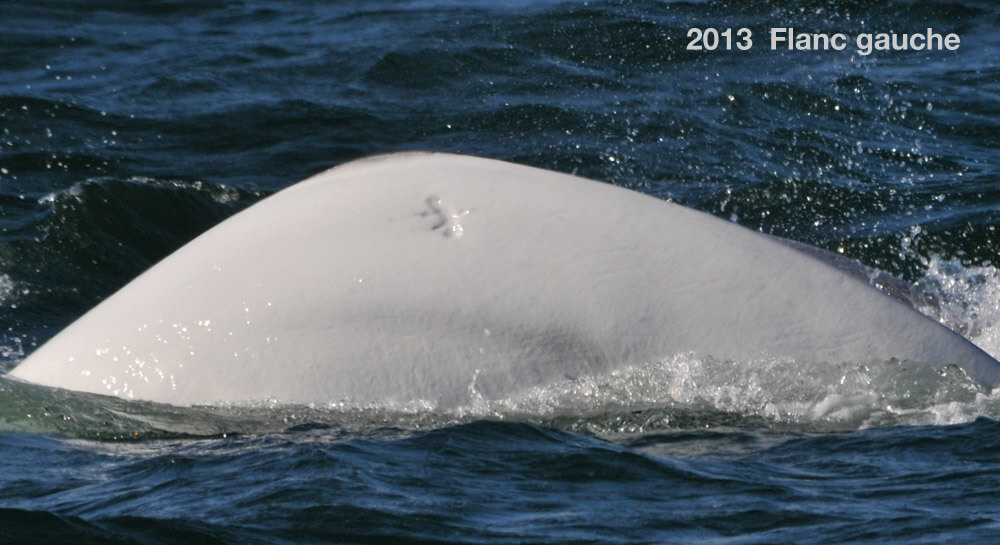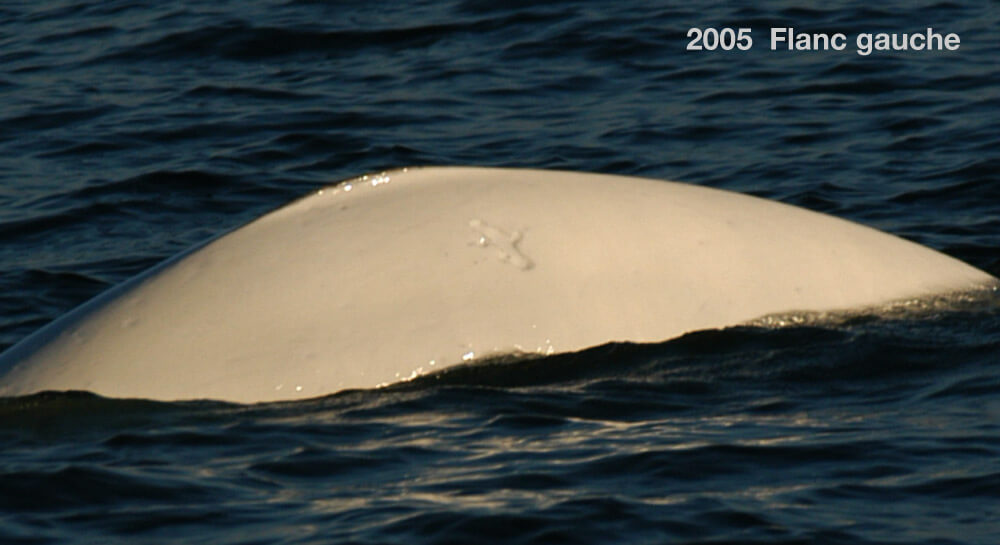DL0584 (1985-2019)
Beluga


Adopted by the naturalists of the GREMM
-
ID number
DL0584
-
Sex
Female
-
Year of birth
Around 1985 (death in 2019)
-
Known Since
1990
Distinctive traits
The dorsal crest of DL0584 has too few markings to identify her. She is recognizable only from her left side thanks to the deep, irregular scar below her dorsal crest, which has become her signature.
Life history
When we first encountered her in 1990, DL0584 was still gray. She gradually faded to become all white in the late 2000s. Her dorsal crest remained black, however, making her easy to identify. Belugas fade from gray to white in colour between the ages of 12 and 16. DL0584 would therefore have been born in the mid-1980s.
DL0584 is a female. In summer, females form large communities in which they tend to newborns and young. These communities are faithful to traditional territories and exchanges between them are uncommon.
DL0584 is regularly observed in the company of Slash and Élizabeth, both members of the Saguenay community. Associations between females of the same community are generally not very stable. They may vary depending on the females’ reproductive status and whether or not they are pregnant or accompanied by a calf.
Over the years, DL0584 has been seen regularly in groups comprising newborns. Once she was seen with a one- or two-year-old individual that seemed to be her own. Mother-calf relationships are difficult to establish with certainty, however. Eventually, once we’ve performed a biopsy, DL0584’s DNA will reveal the details of her family tree.
How DL0584’s story unfolds will teach us volumes on the evolution of belugas’ social lives. By better understanding how belugas live, we will better be able to protect them.
Observations history in the Estuary
Years in which the animal was not observed Years in which the animal was observed
Latest news
An eighth beluga carcass washed up on the banks of the St. Lawrence River on July 4. The individual has been identified as DL0584, a female that had been known to researchers since 1990. The necropsy performed by Stéphane Lair and his veterinarian team is conclusive: DL0584 died during calving. “It was a case of dystocia, which means she was not able to expel the newborn and died as a result,” explains Stéphane Lair.
DL0584 was born around 1985, a datum that can be corroborated by analyzing the growth rings in her teeth. Considering that females reach sexual maturity between the ages of 9 and 12, DL0584 had probably already given birth in the past. She was regularly seen in groups including newborns and was even seen once with a one- or two-year-old calf that appeared to be her own. However, it is difficult to establish with certainty the mother-calf relationship since female belugas occasionally provide care to calves that are not their own, a phenomenon known as allomaternal care. Perhaps genetic analyses will enable researchers to determine this affiliation.
On July 4, the drifting carcass was spotted off the coast of Sainte-Flavie. It washed ashore late in the day. Two volunteers from the Quebec Marine Mammal Emergency Response Network took measurements and documented the carcass, in addition to securing it to prevent it from being washed out with the tide. The 3.84-metre-long carcass was recovered on July 5 and sent to Université de Montréal’s Faculty of Veterinary Medicine in Saint-Hyacinthe. The necropsy was conducted on the morning of July 6.
DL0584 was part of the “Adopt a Beluga” program. Its collective adoption – launched in 2016 under the initiative of the naturalists of the Marine Mammal Interpretation Centre in Tadoussac – had just been completed. The adoption of DL0584 provides funding for scientific research on St. Lawrence belugas.
We’re at the mouth of the Saguenay, heading toward Île Rouge. DL0584 is swimming in a herd of approximately sixty individuals comprising both adults and young, including two newborns. We observe two large concentrations of animals: nearest to us is a group consisting of females and young, followed by a group of adult bulls. DL0584 is in the company of a known female, Miss Frontenac, and the second-year calf of the latter.
The mouth of the Saguenay is a meeting place! Here, networks of male belugas regularly cross paths with those comprising females and young. Short-lived herds form here due to the abundance of food. Moreover, amongst the beluga herd we spot a number of seals, birds, and minke whales. That’s what we call well-stocked waters!
Sponsor
The naturalists of the GREMM adopted DL0584 (2015).
Being a naturalist at the Group for Research and Education on Marine Mammals (GREMM) isn’t just our job, it’s a vocation, even a passion.
We welcome the public, talk to them about whales, tell them stories… we give them a unique experience. We teach them everything we know about the mysterious world of marine mammals, especially those that roam the St. Lawrence. In fact, there are several groups of interpreters and naturalists working for various organizations along the river. We all share the same passion.
Scientific education cannot exist without research. And we protect what we know. As we often say, the health of belugas is a reflection of the health of the St. Lawrence. It’s not just the health and balance of a fragile ecosystem that affects belugas. The river is a source of life, for us and for everything around us.
It’s been a long time coming : the return of “Adopt a Beluga” to support research into these majestic white whales. So, all naturalists, present, former and colleagues, let’s get together and adopt a beluga so that we too can do our part!We’ve chosen DL0584, a beluga that regularly frequents the mouth of the Saguenay. You’ll be able to observe him from the Marine Mammal Interpretation Center (CIMM) in Tadoussac and from the Site d’interprétation et d’observation de Pointe-Noire, on the other side of the fjord.
Once we’ve raised the funds to adopt our beluga, we’ll name it together. Because we need more knowledge to continue protecting them, let’s adopt a beluga!


